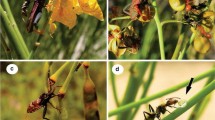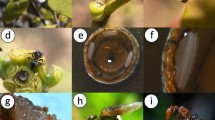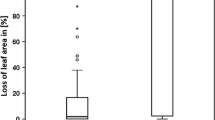Abstract
Protective ant–plant interactions provide valuable model systems to study mutualisms. Here, we summarise our recent research on chemical and physiological adaptations that contribute to the stabilisation of the mutualism between Mesoamerican Acacia host plants and their Pseudomyrmex ant inhabitants against exploiters, that is, species using host-derived rewards without rendering a service. Acacia hosts produce food bodies (FBs) and extrafloral nectar (EFN). Both types of reward are chemically adapted to their specific function as ant food and protected from different exploiters. FBs contained higher amounts of specific proteins than the leaves from which they originate. EFN possessed amino acids making it attractive for the mutualist ants and an invertase making its carbohydrate composition nutritionally suitable for the mutualists but unattractive for generalists. Moreover, pathogenesis-related proteins such as glucanases, chitinases and peroxidases were found in EFN, which likely serve as protection from microorganisms. Digestive adaptations were found that make workers of the ant mutualists dependent on the host-derived food sources, a mechanism that likely counteracts the evolution of cheaters. The ants also possessed a high diversity of bacterial associates, several of which appeared involved in nitrogen fixation, thus contributing to the nutrition of these ‘vegetarian’ ants. By contrast, a non-defending ant species that parasitises the host plants appeared physiologically less adapted to the host-derived food rewards; this species, thus, likely is competitively inferior when colony growth is limited by plant-derived rewards. In summary, several physiological adaptations of both host plants and ants stabilise the Acacia–Pseudomyrmex mutualism against exploitation.





Similar content being viewed by others
References
Agrawal AA (2001) Phenotypic plasticity in the interactions and evolution of species. Science 294:321–326
Baker HG, Baker I (1975) Studies of nectar-constitution and pollinator-plant coevolution. In: Gilbert F, Raven PH (eds) Coevolution of animals and plants. University of Texas Press, Austin, pp 100–140
Baker HG, Opler PA, Baker I (1978) A comparison of the amino acid complements of floral and extrafloral nectars. Bot Gaz 139:322–332
Beach RM, Todd JW, Baker SH (1985) Nectaried and nectariless cotton cultivars as nectar sources for the adult soybean looper. J Entomol Sci 20:233–236
Bentley BL (1977) Extrafloral nectaries and protection by pugnacious bodyguards. Annu Rev Ecol Syst 8:407–427
Bergstrom CT, Lachmann M (2003) The Red King effect: when the slowest runner wins the coevolutionary race. Proc Natl Acad Sci USA 100:593–598
Blüthgen N, Fiedler K (2004) Preferences for sugars and amino acids and their conditionality in a diverse nectar-feeding ant community. J Anim Ecol 73:155–166
Boevé JL, Wäckers FL (2003) Gustatory perception and metabolic utilization of sugars by Myrmica rubra ant workers. Oecologia 136:508–514
Bronstein JL (1994) Our current understanding of mutualism. Q Rev Biol 69:31–51
Bronstein JL (2001) The exploitation of mutualisms. Ecol Lett 4:277–287. doi:10.1046/j.1461-0248.2001.00218.x
Bronstein JL, Huxman T, Horvath B, Farabee M, Davidowitz G (2009) Reproductive biology of Datura wrightii: the benefits of a herbivorous pollinator. Ann Bot 103:1435–1443. doi:10.1093/aob/mcp053
Brouat C, Garcia N, Andary C, McKey D (2001) Plant lock and ant key: pairwise coevolution of an exclusion filter in an ant–plant mutualism. Proc R Soc Lond B 268:2131–2141. doi:10.1098/rspb.2001.1763
Brysch-Herzberg M (2005) Ecology of yeasts in plant–bumblebee mutualism in Central Europe. FEMS Microbiol Ecol 50:87–100
Bshary R, Grutter AS (2005) Punishment and partner switching cause cooperative behaviour in a cleaning mutualism. Biol Lett 1:396–399
Bull JJ, Rice WR (1991) Distinguishing mechanisms for the evolution of co-operation. J Theor Biol 149:63–74. doi:10.1016/S0022-5193(05)80072-4
Carter C, Thornburg RW (2004) Is the nectar redox cycle a floral defense against microbial attack? Trends Plant Sci 9:320–324
Chandler SM, Wilkinson TL, Douglas AE (2008) Impact of plant nutrients on the relationship between a herbivorous insect and its symbiotic bacteria. Proc R Soc Lond B 275:565–570. doi:10.1098/rspb.2007.1478
Clement LW, Köppen S, Brand WA, Heil M (2008) Strategies of a parasite of the ant–Acacia mutualisms. Behav Ecol Sociobiol 26:953–962. doi:10.1007/s00265-007-0520-1
Cornelius ML, Grace JK, Yates JR (1996) Acceptability of different sugars and oils to three tropical ant species (Hymen., Formicidae). Anz Schädlingsk Pflanzensch Umweltsch 69:41–43
Dalecky A, Gaume L, Schatz B, McKey D, Kjellberg F (2005) Facultative polygyny in the plant–ant Petalomyrmex phylax (Hymenoptera : Formicinae): sociogenetic and ecological determinants of queen number. Biol J Linn Soc 86:133–151
Davidson DW, Patrell-Kim L (1996) Tropical arboreal ants: why so abundant? In: Gibson AC (ed) Neotropical biodiversity and conservation. Mildred E. Mathias Botanical Garden, University of California, Los Angeles, pp 127–140
Davidson DW, Cook SC, Snelling RR, Chua TH (2003) Explaining the abundance of ants in lowland tropical rainforest canopies. Science 300:969–972. doi:10.1126/science.1082074
Dean MD (2006) A Wolbachia-associated fitness benefit depends on genetic background in Drosophila simulans. Proc R Soc Lond B 273:1415–1420. doi:10.1098/rspb.2005.3453
Denison RF, Kiers ET (2004) Lifestyle alternatives for rhizobia: mutualism, parasitism, and forgoing symbiosis. FEMS Microbiol Lett 237:187–193
Doebeli M, Hauert C (2005) Models of cooperation based on the Prisoner’s Dilemma and the Snowdrift game. Ecol Lett 8:748–766. doi:10.1111/j.1461-0248.2005.00773.x
Doebeli M, Knowlton N (1998) The evolution of interspecific mutualisms. Proc Natl Acad Sci USA 95:8676–8680
Doebeli M, Hauert C, Killingback T (2004) The evolutionary origin of cooperators and defectors. Science 306:859–862
Douglas AE (2008) Conflict, cheats and the persistence of symbioses. New Phytol 177:849–858
Duarte Rocha CF, Godoy Bergallo H (1992) Bigger ant colonies reduce herbivory and herbivore residence time on leaves of an ant–plant: Azteca muelleri vs. Coelomera ruficornis on Cecropia pachystachia. Oecologia 91:249–252
Edwards DP, Hassall M, Sutherland WJ, Yu DW (2006) Selection for protection in an ant–plant mutualism: host sanctions, host modularity and the principal-agent game. Proc R Soc Lond B 273:595–602. doi:10.1098/rspb.2005.3273
Eilmus S, Heil M (2009) Bacterial associates of arboreal ants and their putative functions in an obligate ant–plant mutualism. Appl Environ Microbiol 75:4324–4332. doi:10.1128/AEM.00455-09
Federle W, Fiala B, Zizka G, Maschwitz U (2001) Incident daylight as orientation cue for hole-boring ants: prostomata in Macaranga ant–plants. Ins Soc 48:165–177
Feldhaar H, Fiala B, bin Hashim R, Maschwitz U (2000) Maintaining an ant–plant symbiosis: secondary polygyny in the Macaranga triloba-Crematogaster sp. association. Naturwissenschaften 87:408–411
Ferrière R, Gauduchon M, Bronstein JL (2007) Evolution and persistence of obligate mutualists and exploiters: competition for partners and evolutionary immunization. Ecol Lett 10:115–126. doi:10.1111/j.1461-0248.2006.01008.x
Folgarait PJ, Johnson HL, Davidson DW (1994) Responses of Cecropia to experimental removal of Müllerian bodies. Funct Ecol 8:22–28
Fonseca CR (1993) Nesting space limits colony size of the plant–ant Pseudomyrmex concolor. Oikos 67:473–482
Foster KR, Wenseleers T (2006) A general model for the evolution of mutualisms. J Evol Biol 19:1283–1293
Gaume L, McKey D (1999) An ant–plant mutualism and its host-specific parasite: activity rhythms, young leaf patrolling, and effects on herbivores of two specialist plant–ants inhabiting the same myrmecophyte. Oikos 84:130–144
Gaume L, Zacharias M, Borges RM (2005) Ant–plant conflicts and a novel case of castration parasitism in a myrmecophyte. Evol Ecol Res 7:435–452
González-Teuber M, Heil M (2009) The role of extrafloral nectar amino acids for the preferences of facultative and obligate ant mutualists. J Chem Ecol 35:459–468. doi:10.1007/s10886-009-9618-4
González-Teuber M, Eilmus S, Muck A, Svatos A, Heil M (2009) Pathogenesis-related proteins protect extrafloral nectar from microbial infestation. Plant J 58:464–473. doi:10.1111/j.1365-313X.2009.03790.x
Hamilton WD (1964) The genetical evolution of social behaviour I and II. J Theor Biol 7:1–16, 17–52
Heil M (2008) Indirect defence via tritrophic interactions. New Phytol 178:41–61. doi:10.1111/j.1469-8137.2007.02330.x
Heil M, McKey D (2003) Protective ant–plant interactions as model systems in ecological and evolutionary research. Annu Rev Ecol Evol Syst 34:425–453. doi:10.1146/annurev.ecolsys.34.011802.132410
Heil M, Fiala B, Linsenmair KE, Zotz G, Menke P, Maschwitz U (1997) Food body production in Macaranga triloba (Euphorbiaceae): a plant investment in anti-herbivore defence via mutualistic ant partners. J Ecol 85:847–861
Heil M, Fiala B, Baumann B, Linsenmair KE (2000) Temporal, spatial and biotic variations in extrafloral nectar secretion by Macaranga tanarius. Funct Ecol 14:749–757. doi:10.1046/j.1365-2435.2000.00480.x
Heil M, Hilpert A, Fiala B, Linsenmair KE (2001a) Nutrient availability and indirect (biotic) defence in a Malaysian ant–plant. Oecologia 126:404–408. doi:10.1007/s004420000534
Heil M, Koch T, Hilpert A, Fiala B, Boland W, Linsenmair KE (2001b) Extrafloral nectar production of the ant-associated plant, Macaranga tanarius, is an induced, indirect, defensive response elicited by jasmonic acid. Proc Natl Acad Sci USA 98:1083–1088
Heil M, Baumann B, Krüger R, Linsenmair KE (2004a) Main nutrient compounds in food bodies of Mexican Acacia ant–plants. Chemoecology 14:45–52. doi:10.1007/s00049-003-0257-x
Heil M, Greiner S, Meimberg H, Krüger R, Noyer J-L, Heubl G, Linsenmair KE, Boland W (2004b) Evolutionary change from induced to constitutive expression of an indirect plant resistance. Nature 430:205–208. doi:10.1038/nature02703
Heil M, Hilpert A, Krüger R, Linsenmair KE (2004c) Competition among visitors to extrafloral nectaries as a source of ecological costs of an indirect defence. J Trop Ecol 20:201–208. doi:10.1017/S026646740300110X
Heil M, Rattke J, Boland W (2005) Post-secretory hydrolysis of nectar sucrose and specialization in ant/plant mutualism. Science 308:560–563. doi:10.1126/science.1107536
Heil M, González-Teuber M, Clement LW, Kautz S, Verhaagh M, Silva Bueno JC (2009) Divergent investment strategies of Acacia myrmecophytes and the coexistence of mutualists and exploiters. Proc Natl Acad Sci USA 106:18091–18096. doi:10.1073/pnas.0904304106
Herrera CM, Garcia IM, Perez R (2008) Invisible floral larcenies: microbial communities degrade floral nectar of bumble bee-pollinated plants. Ecology 89:2369–2376
Herrera CM, De Vega C, Canto A, Pozo MI (2009) Yeasts in floral nectar: a quantitative survey. Ann Bot 103:1415–1423. doi:10.1093/aob/mcp026
Hilgenboecker K, Hammerstein P, Schlattmann P, Telschow A, Werren JH (2008) How many species are infected with Wolbachia?—a statistical analysis of current data. FEMS Microbiol Lett 281:215–220. doi:10.1111/j.1574-6968.2008.01110.x
Hoeksema JD, Bruna EM (2000) Pursuing the big questions about interspecific mutualism: a review of theoretical approaches. Oecologia 125:321–330. doi:10.1007/s004420000496
Hoeksema JD, Kummel M (2003) Ecological persistence of the plant-mycorrhizal mutualism: a hypothesis from species coexistence theory. Am Nat 162:S40–S50. doi:10.1086/378644
Hölldobler B, Wilson EO (1990) The ants. Springer, Berlin
Izzo TJ, Vasconcelos HL (2002) Cheating the cheater: domatia loss minimizes the effects of ant castration in an Amazonian ant–plant. Oecologia 133:200–205. doi:10.1007/s00442-002-1027-0
Janzen DH (1966) Coevolution of mutualism between ants and acacias in Central America. Evolution 20:249–275
Janzen DH (1974) Swollen-thorn acacias of Central America. Smithsonian Institution Press, Washington
Janzen DH (1975) Pseudomyrmex nigropilosa: a parasite of a mutualism. Science 188:936–937. doi:10.1126/science.188.4191.936
Kautz S, Lumbsch HT, Ward PS, Heil M (2009a) How to prevent cheating: a digestive specialization ties mutualistic plant–ants to their ant–plant partners. Evolution 63:839–853. doi:10.1111/j.1558-5646.2008.00594.x
Kautz S, Pauls SU, Ballhorn DJ, Heil M (2009b) Polygynous supercolonies of the acacia–ant Pseudomyrmex peperi, an inferior colony founder. Mol Ecol. doi:10.1111/j.1365-294X.2009.04395.x
Kautz S, Schmid VS, Trindl A, Heinze J, Ballhorn DJ, Heil M (2009c) Isolation and characterization of microsatellite loci in the plant–ant Pseudomyrmex ferrugineus (Formicidae: Pseudomyrmecinae) and cross-testing for two congeneric species. Mol Ecol Resources 9:1016–1019. doi:10.1111/j.1755-0998.2009.02569.x
Kiers ET, Rousseau RA, West SA, Denison RF (2003) Host sanctions and the legume–rhizobium mutualism. Nature 425:78–81. doi:10.1038/nature01931
Kobayashi S, Asai T, Fujimoto Y, Kohshima S (2008) Anti-herbivore structures of Paulownia tomentosa: morphology, distribution, chemical constituents and changes during shoot and leaf development. Ann Bot 101:1035–1047. doi:10.1093/aob/mcn033
Koptur S (1992) Extrafloral nectary-mediated interactions between insects and plants. In: Bernays EA (ed) Insect–plant interactions, vol IV. CRC Press, Boca Raton, pp 81–129
Lanza J, Vargo EL, Pulim S, Chang YZ (1993) Preferences of the fire ants Solenopsis invicta and S. geminata (Hymenoptera: Formicidae) for amino acid and sugar components of extrafloral nectars. Environ Entomol 22:411–417
Letourneau DK (1990) Code of ant–plant mutualism broken by parasite. Science 248:215–217. doi:10.1126/science.248.4952.215
Limpens E, Bisseling T (2003) Signaling in symbiosis. Curr Opin Plant Biol 6:343–350
Mithöfer A (2002) Suppression of plant defence in rhizobia–legume symbiosis. Trends Plant Sci 10:440–444
Mody K, Linsenmair KE (2004) Plant-attracted ants affect arthropod community structure but not necessarily herbivory. Ecol Entomol 29:217–225
Mondor EB, Addicott JF (2003) Conspicuous extra-floral nectaries are inducible in Vicia faba. Ecol Lett 6:495–497
Morris WF, Bronstein JL, Wilson WG (2003) Three-way coexistence in obligate mutualist-exploiter interactions: the potential role of competition. Am Nat 161:860–875
Nardi JB, Mackie RI, Dawson JO (2002) Could microbial symbionts of arthropod guts contribute significantly to nitrogen fixation in terrestrial ecosystems? J Insect Physiol 48:751–763
Ness JH, Morris WF, Bronstein JL (2006) Integrating quality and quantity of mutualistic service to contrast ant species protecting Ferocactus wislizeni. Ecology 87:912–921
Nicolson SW, Thornburg RW (2007) Nectar chemistry. In: Nicolson SW, Nepi M, Pacini E (eds) Nectaries and nectar. Springer, Heidelberg, pp 215–263
Palmer TM (2004) Wars of attrition: colony size determines competitive outcomes in a guild of African acacia ants. Anim Behav 68:993–1004
Pellmyr O, Huth CJ (1994) Evolutionary stability of mutualism between yuccas and yucca moth. Nature 372:257–260
Perlman SJ, Hunter MS, Zchori-Fein E (2006) The emerging diversity of Rickettsia. Proc R Soc Lond B 273:2097–2106. doi:10.1098/rspb.2006.3541
Pulice CE, Packer AA (2008) Simulated herbivory induces extrafloral nectary production in Prunus avium. Funct Ecol 22:801–807. doi:10.1111/j.1365-2435.2008.01440.x
Raine NE, Gammans N, Macfadyen IJ, Scrivner GK, Stone GN (2004) Guards and thieves: antagonistic interactions between two ant species coexisting on the same ant–plant. Ecol Entomol 29:345–352. doi:10.1111/j.0307-6946.2004.00608.x
Rickson FR (1969) Developmental aspects of the shoot apex, leaf, and Beltian bodies of Acacia cornigera. Am J Bot 56:195–200
Rickson FR (1975) The ultrastructure of Acacia cornigera L. Beltian body tissue. Am J Bot 62:913–922
Risch SJ, Rickson F (1981) Mutualism in which ants must be present before plants produce food bodies. Nature 291:149–150. doi:10.1038/291149a0
Roesch C, Bothe H (2005) Improved assessment of denitrifying, nitrogen-fixing, and total-community bacteria by terminal restriction fragment length polymorphism [tRFLP] analysis using multiple restriction enzymes. Appl Environ Microbiol 71:2026–2035
Rogers WE, Siemann E, Lankau RA (2003) Damage induced production of extrafloral nectaries in native and invasive seedlings of Chinese tallow tree (Sapium sebiferum). Am Midl Natural 149:413–417
Sachs JL, Simms EL (2006) Pathways to mutualism breakdown. Trends Ecol Evol 21:585–592. doi:10.1016/j.tree.2006.06.018
Sachs JL, Mueller UG, Wilcox TP, Bull JJ (2004) The evolution of cooperation. Q Rev Biol 79:135–160
Sandhu DK, Waraich MK (1985) Yeast associated with pollinating bees and flower nectar. Microbial Ecol 11:51–58
Segraves K, Althoff D, Pellmyr O (2005) Limiting cheaters in mutualism: evidence from hybridization between mutualist and cheater yucca moths. Proc R Soc Lond B 272:2195–2201
Simms EL, Taylor DL, Povich J, Shefferson RP, Sachs JL, Urbina M, Tausczik Y (2006) An empirical test of partner choice mechanisms in a wild legume–rhizobium interaction. Proc R Soc Lond B 273:77–81
Stapel JO, Cortesero AM, DeMoraes CM, Tumlinson JH, Lewis WJ (1997) Extrafloral nectar, honeydew, and sucrose effects on searching behavior and efficiency of Microplitis croceipes (Hymenoptera: Braconidae) in cotton. Environ Entomol 26:617–623
Stoll S, Gadau J, Gross R, Feldhaar H (2007) Bacterial microbiota associated with ants of the genus Tetraponera. Biol J Linn Soc 90:399–412. doi:10.1111/j.1095-8312.2006.00730.x
Sultan SE (2000) Phenotypic plasticity for plant development, function and life history. Trends Plant Sci 5:537–542
Thornburg RW (2007) Molecular biology of the Nicotiana floral nectary. In: Nicolson SW, Nepi M, Pacini E (eds) Nectaries and Nectar. Springer, Heidelberg, pp 265–287
Thornburg RW, Carter C, Powell A, Mittler R, Rizhsky L, Horner HT (2003) A major function of the tobacco floral nectary is defense against microbial attack. Plant Syst Evol 238:211–218
Tillberg CV (2004) Friend or foe? A behavioral and stable isotopic investigation of an ant–plant symbiosis. Oecologia 140:506–515. doi:10.1007/s00442-004-1601-8
Tobin JE (1995) Ecology and diversity of tropical forest canopy ants. In: Lowman MD, Nadkarni NM (eds) Forest canopies. Academic Press, San Diego, pp 129–147
Van Loon LC, Van Strien EA (1999) The families of pathogenesis-related proteins, their activities, and comparative analysis of PR-1 type proteins. Physiol Mol Plant Pathol 55:85–97
Van Loon LC, Rep M, Pieterse CMJ (2006) Significance of inducible defense-related proteins in infected plants. Annu Rev Phytopathol 44:135–162
Vander Meer RK, Lofgren CS, Seawright JA (1995) Specificity of the red imported fire ant (Hymenoptera, Formicidae) phagostimulant response to carbohydrates. Florida Entomol 78:144–154
Wäckers FL, Wunderlin R (1999) Induction of cotton extrafloral nectar production in response to herbivory does not require a herbivore-specific elicitor. Entomol Exp Appl 91:149–154
Ward PS (1993) Systematic studies on Pseudomyrmex acacia–ants (Hymenoptera: Formicidae: Pseudomyrmecinae). J Hym Res 2:117–168
Werren JH, Windsor D, Guo LR (1995) Distribution of Wolbachia among neotropical arthropods. Proc R Soc Lond B 262:197–204
West SA, Kiers ET, Simms EL, Denison RF (2002) Sanctions and mutualism stability: why do rhizobia fix nitrogen? Proc R Soc Lond B Biol Sci 269:685–694
Wooley SC, Donaldson JR, Gusse AC, Lindroth RL, Stevens MT (2007) Extrafloral nectaries in aspen (Populus tremuloides): Heritable genetic variation and herbivore-induced expression. Ann Bot 100:1337–1346. doi:10.1093/aob/mcm220
Yu DW (2001) Parasites of mutualisms. Biol J Linn Soc 72:529–546
Yu DW, Pierce NE (1998) A castration parasite of an ant–plant mutualism. Proc R Soc Lond B 265:375–382. doi:10.1098/rspb.1998.0305
Zientz E, Beyaert N, Gross R, Feldhaar H (2006) Relevance of the endosymbiosis of Blochmannia floridanus and carpenter ants at different stages of the life cycle of the host. Schriftenr Vegetationskunde 72:6027–6033
Acknowledgments
We thank Rosa Maria Adame-Álvarez, Ralf Krüger and Juan Carlos Silva Bueno for help with field work, Doyle McKey for many valuable comments on an earlier version of this manuscript and the German Research Foundation (DFG grant He3169/4-2) and CONACyT for financial support.
Author information
Authors and Affiliations
Corresponding author
Rights and permissions
About this article
Cite this article
Heil, M., Orona-Tamayo, D., Eilmus, S. et al. Chemical communication and coevolution in an ant–plant mutualism. Chemoecology 20, 63–74 (2010). https://doi.org/10.1007/s00049-009-0036-4
Received:
Accepted:
Published:
Issue Date:
DOI: https://doi.org/10.1007/s00049-009-0036-4




